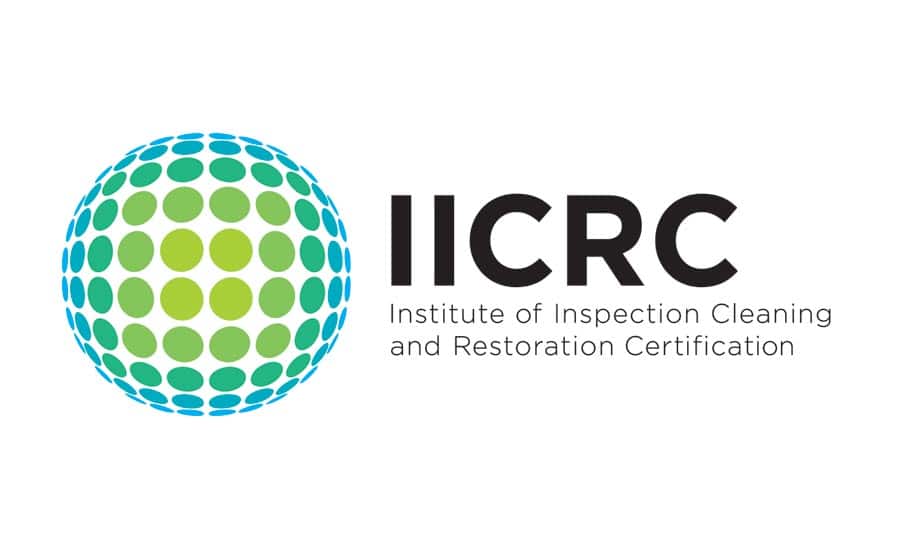
The IICRC stands for the Institute of Inspection Cleaning and Restoration Certification. This non-profit organisation is involved in the cleaning and restoration industry, to set and develop standards and certifications recognised worldwide.
The IICRC offers a whole range of expert standards and certifications, which give in-depth instruction in specialist cleaning and restoration services.
You might be surprised at the range and depth of these accreditations. For instance, did you know they provide training and certifications for subjects as specialised as odour control, trauma and crime scene cleaning and mould removal? They also set a whole host of standards for various topics including water damage restoration on commercial structures, professional fire and smoke restoration and professional mould remediation.
They encourage and endorse continuing education through conventions, specialised training and workshops for anyone who has studied with them, their ethos being that learning never stops.
This means that not only do they provide high level, professional training, they also ensure that this learning and knowledge are refreshed continuously and their graduates keep up with the latest techniques.
This in-depth course firstly requires that the candidate has completed the Water Damage Restoration Technician course, demonstrating an understanding of water damage in buildings and its effects, as well as techniques for drying out commercial and residential properties. By undertaking this course, the technician will also know how to manage water losses, sewer backflows and contamination including mould.
Prepared with this in-depth knowledge, the technician may then undertake the Applied Microbial Remediation Technician course to gain a deeper understanding of how to deal with mould and sewage issues using the latest techniques, all the while ensuring the highest health and safety standards.
This means that the technician will be fully equipped to understand the science behind microbes and mould, and how best to deal with this problem efficiently without the risk of it returning.
If you’re seeking a mould removal service, there are many benefits to appointing a technician who has undergone IICRC Mould Remediation Certification as opposed to someone who has not achieved this high level of training.
There is a world of difference between simply cleaning off mould that may appear on a wall or interior surface, and understanding what type of mould it is, what its potential effects could be and ensuring that it is removed entirely and not given a chance to return.
To understand this difference more fully, it helps to know a bit more about mould and how it thrives. Mould is a living organism within the fungi family. It is usually visible as black discolouration on a surface such as a wall. Here it will be feeding off a food source available on the surface, as it cannot produce its food. This will be some sort of organic material, which is one of the conditions it needs to thrive.
It also requires moisture, optimum temperature and the ability to reproduce by releasing tiny spores which can be airborne. When the conditions are ripe, these spores reproduce, and you will see the resulting mould once they have had the chance to form colonies.
Mould tends to grow in damp conditions, so typically in poorly ventilated bathrooms, around leaking pipes or air conditioning systems, or following water damage to your premises.
Mould can pose a threat to the health of humans, in particular to children, pregnant women, people with chronic health conditions and seniors. Some people can be affected by mould allergies, with symptoms including coughing, wheezing, chest congestion, sore throats, watering eyes and headaches. It can also cause lung infections, with people with existing conditions such as COPD (Chronic Obstructive Pulmonary Disorder) particularly vulnerable, and trigger respiratory conditions such as asthma.
Long-term exposure to mycotoxins, poisonous chemicals released by mould, can result in even more serious health consequences.
Armed with the knowledge described above, an IICRC certified technician will assess the situation as a first step to removing the existing mould and preventing it from returning in a home or commercial premise
The assessment will involve the technician identifying the extent of mould contamination evident on the building structure, the potential sources of moisture that are causing the mould contamination, the extent of mould contamination on the contents of the building and determining the best remediation method to be used whilst being very mindful of the health and safety of building occupants.
The first step in the remediation process is to adequately contain the contaminated areas of the home or building and to prevent the cross contamination of unaffected areas. Containment systems or engineering controls can include isolating areas with plastic sheet barriers, installing negative air machines and other air filtration devices to ensure air movement does not allow airborne particles to move from the contaminated areas to the clean areas of the home or building. Fungicides are often used in the cleaning process however these can be adequately replaced with natural cleaning compounds in many situations. Specialised equipment is then used to dry out any areas affected by water or moisture. Once the area is dry, the reinstatement of materials can occur safely.
The successful treatment of mould involves more than a surface clean of the affected area. With their in-depth knowledge of mould and its characteristics, as well as specialised equipment and techniques, IICRC certified technicians are fully equipped to efficiently identify and remove mould in residential or commercial premises, and prevent its return. The result is a clean, healthy building and peace of mind for its occupants.
PureProtect is a corporate member of IICRC and our technicians all undergo IICRC training and certification. You can learn more about IICRC training on their website. Otherwise, give PureProtect a call on 1800 664 602, and we would be happy to talk to you about our training and why we can remove mould from your home or business safely.
PureProtect Pty Ltd © 2020. All rights reserved